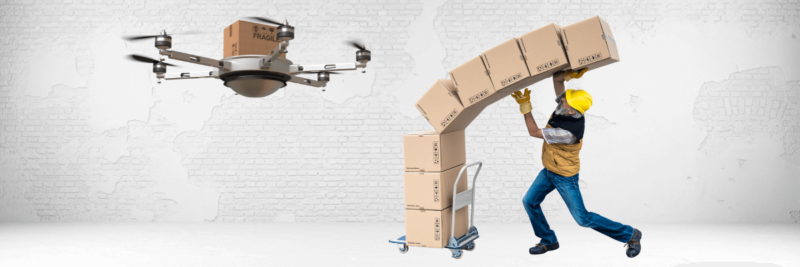Product Returns: A Trillion Dollar Challenge
Consumers are returning products more and more often – how can the retail industry cope with the cost?
The changes in retail in recent years, that accelerated even more by the rise of e-commerce and, of course, the pandemic, include a new major challenge for merchants, which in previous years was not so prominent: the issue of returns. Now, returns are considered an integral part of the customer journey and something that will concern commerce more in the future.
Even before the outbreak of the pandemic, however, there were signs that returns would become an increasingly important part of the shopping experience. In 2019, Tobin Moore, CEO of Optoro, noted that in the coming years, as e-commerce grows around the world, “the value of returns will reach $1 trillion dollars a year”. At the same time, David Sobie, co-founder & CEO of Happy Returns had mentioned the difference in the rate of consumer returns when buying something in stores compared to returns in online purchases, with the rate of the former being 5-10% and of the latter 15-40%.
The returns keep increasing
In subsequent years, the data showed that the rate of returns was constantly increasing. According to data released in early 2022 by the National Retail Federation (NRF) and Appriss Retail, in 2021 the overall return rate in the US was 16.6% compared to 10.6% in 2020, with online shopping returns however stabilizing at 20.8%. According to the same report, in the US alone for every $100 in returned merchandise accepted, retailers lose $10.30. At the same time, retailers expect more than $761 billion worth of merchandise sold through 2021 to be returned by consumers. This means that refunds are already a $1 trillion problem and will continue to be an even bigger problem in the near future.
According to a McKinsey survey published in May 2021, nearly 75% of retailers agree that returns are “a necessary evil”. They are now a part of business that is often overlooked, but has a huge impact on their brand. In fact, 84% of consumers polled by Doddle, as cited in the same survey, said that the returns experience plays an important role in their opinion of a retailer, while around 95% noted that a poor returns experience will make it less likely that they will make a purchase from a particular brand again.
Addressing the issue of returns
Nevertheless, how can a retailer deal with the rising costs of returns and in what ways can this new reality not become a significant burden on their business?
Certainly, actions that can limit the possibility of returns play an important role. A quality check on the products can prevent a negative experience from consumers, which will lead them to product returns, as well as errors (especially on sites and online sales) that can lead the brand’s customers to wrong purchases. The products must be presented accurately on the site of a brand or store, so that there are no doubts among the buyers. Particular attention should be paid (especially in shopping for clothing and footwear) to the correct display of colors and sizes, while ways for consumers to calculate their size correctly, even online where there is no possibility to try on (via special software or even charts), can help to avoid buying a product that needs to be returned. Augmented reality apps that help a consumer better imagine an object in their space or an accessory on them can lead to purchases for which users feel more confident.
Of course, as part of the online purchase experience, shipping also plays an important role, as a rough or wrong packaging can result in a broken or damaged product reaching the consumer, which will necessarily have to be returned and replaced, with a significant cost to the retailer.
Educating consumers
It is important to have some provisions regarding the store’s return policies that are clear to consumers in advance. The entire procedure must be accurately described in such a case, as well as who bears the cost. In many cases, charging for e-shopping returns is a preferred solution. Not long ago, the leading clothing chain Zara became the latest retailer to start charging shoppers to return products bought online if the return is not made in one of the company’s stores. European customers must pay €3.45 to return their purchases, with the cost deducted from the refund amount. Products bought online can still be returned free of charge to chain stores, which presents many advantages as a method. A consumer who goes to the store even to return a product is more likely to buy something new or something extra that they saw in front of them. Additionaly, the returned product is back on the shelf for sale sooner than if the postal route was followed, reducing risk of withdrawing from the sale because e.g. its time has expired or it went out of fashion/season.
If the store cannot bear the burden of the refund, it can clearly state that it is refunding to a gift card or loyalty card instead of cash or to the customer’s credit/debt card.
Regarding businesses that also maintain physical stores in particular, there are modern automated solutions that speed up returns and put less burden on a store and its staff. For example, some retailers abroad are already implementing the solution of special “Return Bars“, i.e. special points where customers can deliver their returns quickly, using QR codes or another method. Technological developments in the retail sector are an ally in this case as well, offering solutions that make the chain that connects the merchant with the consumer more efficient, bringing the products faster from one end to the other, revealing -through data analysis- audience preferences and areas for improvement, reducing costs and increasing customer satisfaction.
Returns are a necessary evil for merchants, but one they can deal with without significant negative consequences. What they need to do is turn in-store product returns into a good shopping experience for their customers and see the new reality as an opportunity from which they can get valuable data for the development of their business.
What do the experts recommend? Place more emphasis on increasing first sales and customer satisfaction, so that the cost of returns becomes less and less. The problem of returns is one of the topics discussed at the 1st Retail Tech Communities Workgroup, organized by Cardlink with the support of Found.ation, as part of the Retail Innovation Hub actions. Read more insights regarding the challenges retail faces, and what the experts have to say in our free Retail Insights Memo.



